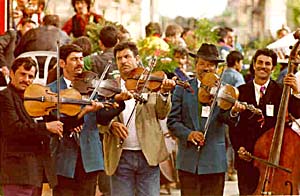Gypsies Fiddle Madly as Classical Spirits Hover
The New York Times
Gypsies Fiddle Madly as Classical Spirits Hover
By ANNE MIDGETTE
April 14, 2001
 The performance was born of a good idea: to contrast Hungarian classical music familiar from the concert hall – Liszt, Dohnanyi, Bartok – with original Gypsy prototypes. And for its Thursday night concert at the 92nd Street Y, the second of two explorations of Roma (Gypsy) music this month, the Perspectives Ensemble found some good musicians in the two Roma musical groups they invited from Hungary to join them. They failed, however, to go the extra step to knit the whole thing together into a meaningful whole, and the concert was thus less a focused exploration than an uneven medley.
The performance was born of a good idea: to contrast Hungarian classical music familiar from the concert hall – Liszt, Dohnanyi, Bartok – with original Gypsy prototypes. And for its Thursday night concert at the 92nd Street Y, the second of two explorations of Roma (Gypsy) music this month, the Perspectives Ensemble found some good musicians in the two Roma musical groups they invited from Hungary to join them. They failed, however, to go the extra step to knit the whole thing together into a meaningful whole, and the concert was thus less a focused exploration than an uneven medley.
Far and away the star among the Hungarians was Kalman Balogh, a cimbalom player of considerable virtuosity. The cimbalom is a variety of zither or dulcimer, a pretty little tablelike instrument, and Mr. Balogh put it through its paces, first plucking its strings, then striking them with various sets of hammers to present a whole range of sound colors in his dazzling opening piece by an 18th-century cimbalom player named Pal Tendi.
 Another guest was Ferenc Santa Jr., scion of an evidently well-known family of Roma musicians, the very embodiment of a Gypsy violinist, offering selections from a traditional “Lamenting Song” to czardases. Then there was the Szaszcsavas Band, a group of six poker-faced men playing violins, kontras (a kind of viola) and a bass in an ensemble that, with its loosely strung bows copiously laden with rosin, had a scratchy drone vaguely reminiscent of bagpipes.
Another guest was Ferenc Santa Jr., scion of an evidently well-known family of Roma musicians, the very embodiment of a Gypsy violinist, offering selections from a traditional “Lamenting Song” to czardases. Then there was the Szaszcsavas Band, a group of six poker-faced men playing violins, kontras (a kind of viola) and a bass in an ensemble that, with its loosely strung bows copiously laden with rosin, had a scratchy drone vaguely reminiscent of bagpipes.
But no one, it seemed, had figured out how to make all these disparate elements actually work together on stage. By default each group pretty much did its own thing. As a result, there didn’t seem to be much relation between, say, the Szaszcsavas Band’s village-style Transylvanian dances and Bartok’s marvelous “Contrasts”; although “Contrasts” is based on the same types of traditional dances, it is speaking a very different, more sophisticated language.
The most successful juxtaposition was that of Mr. Santa’s “Lamenting Song” with Dohnanyi’s “Ruralica Hungarica,” with Erica Kiesewetter as the accurate violinist and Diane Walsh as a strong and sensitive piano accompanist; this pairing more concretely demonstrated, on the same instrument, how classical pieces grow out of folk styles.
Over all, however, the evening was more a cross-section of different aspects of Hungarian music than an exploration of influence, cause and effect, especially because of the different styles of the performers. From the classical side the high point was “Contrasts,” with Jon Manasse, another guest artist, doing a fine job with a clarinet part originally written for Benny Goodman. The Gypsies for their part moved from Mr. Balogh’s serious musicianship to increasingly crowd-pleasing antics. Mr. Santa’s comic encore had his violin imitating birdcalls and an ambulance siren; while the members of the Szaszcsavas Band took turns performing Transylvanian Gypsy dances, with much kicking of heels and slapping of legs.
Ms. Walsh, sandwiched between these two extremes, gave the Gypsies a run for their money with a very respectable account of two Liszt Hungarian Rhapsodies, complete with a full-powered fusillade of the 11th Rhapsody’s concluding fireworks. Still, while the Perspectives Ensemble took the evening’s musical palm, the Roma walked away with a healthy chunk of the audience in their pockets.
Copyright 2001 The New York Times Company